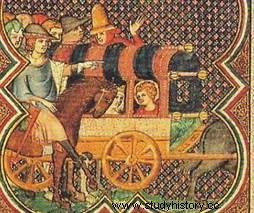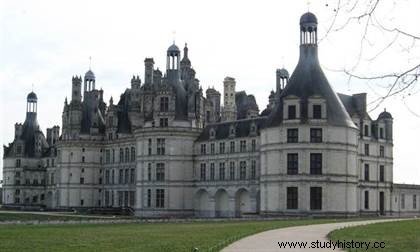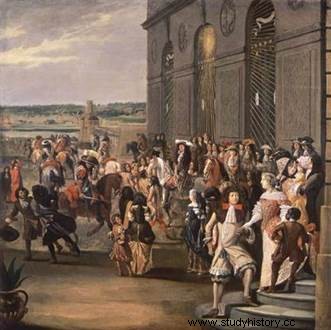 Since Charlemagne, the King's Court travel, sometimes for long months, from towns to villages, from residences to palaces, for economic or political reasons or for pleasure, having no fixed place until Louis XIV and his court settled definitively at the castle of Versailles in 1682, the palace taking on the status of "State Palace", hosting the royal family, courtiers and many government services. A system of prestigious expenditure was put in place at Versailles, essential to show its integration into court society , punctuated by etiquette, a rigid code of social relations based on a strict hierarchy.
Since Charlemagne, the King's Court travel, sometimes for long months, from towns to villages, from residences to palaces, for economic or political reasons or for pleasure, having no fixed place until Louis XIV and his court settled definitively at the castle of Versailles in 1682, the palace taking on the status of "State Palace", hosting the royal family, courtiers and many government services. A system of prestigious expenditure was put in place at Versailles, essential to show its integration into court society , punctuated by etiquette, a rigid code of social relations based on a strict hierarchy.
The need to move
During antiquity, the king's court remained at a central point, a fixed place, and the emperor was surrounded on the spot by administrative structures. The Merovingian kings also stayed in town, notably Soissons and Paris. Gradually, Charlemagne began to break with habits and the Court became itinerant:he made many stays in northern and eastern Europe, the Carolingian empire having large proportions. He manages to travel 10,000 km between 794 and 804, or about 1000 km per year!
 In the Middle Ages, to exercise his power, the king had to go to the provinces to collect royalties which were well often paid in products to be consumed on the spot, but also to exercise justice, charity and respond to the requests of the subjects. The king does not leave alone, the Court follows, crossing the kingdom, from towns to villages, from palaces to castles, rarely staying more than a few weeks in the same place.
In the Middle Ages, to exercise his power, the king had to go to the provinces to collect royalties which were well often paid in products to be consumed on the spot, but also to exercise justice, charity and respond to the requests of the subjects. The king does not leave alone, the Court follows, crossing the kingdom, from towns to villages, from palaces to castles, rarely staying more than a few weeks in the same place.
From the 12th and 13th centuries, habits changed seriously:royalties were paid in money, royal and judicial administration was entrusted to the few provincial intendants, as in 1515 when they were only 5,000, that is one officer for 3,000 inhabitants and 155 km2; the royal writings and deeds are sent by couriers, the king manages his country from a distance and therefore travels a little less. But he must know his people, be loved by his subjects and therefore must show himself.
The king's court takes the "grand tour"
The most striking example is the "grand tour" organized by Catherine de Medici to "show" her son Charles IX, a 4,000 km journey that lasted 27 months between 1564 and 1566. The procession of the King's Court can reach 10,000 people, made up of courtiers, servants, people from the king's council, the chancellery, the archives and the treasury and as many animals (bears, birds, packs of dogs for hunting, horses) without forgetting the carts carrying furniture, linen, tapestries, crockery...at a pace of 20 km per day. This "great tour" was nevertheless punctuated with major problems:10 days of additional stop in Carcassonne due to snow, changes to the route due to flooding in the spring, the death of humans and horses due to the heat in summer. , extended parking in Crémieu to avoid the plague raging in Lyon.
These are very big celebrations at each entrance to the cities, but significant expenses and major stewardship problems, in terms of housing and food. The city requisitioned apartments as in 1533 in Marseilles for the marriage of Henri and Catherine de Médicis. A bourgeois who has the honor of lodging the Marquis de Saluzzo and his retinue recounts "on Wednesday, September 24, the Marquis de Saluzzi arrives in Marseilles, he was sent to my house and to lodge him with his suite, it was necessary to drill my room and set up the wardrobe in Comrade Monthavan's bedroom. They did the cooking in Mr. Baylier's house, so that they cluttered up everywhere. The marquis slept in my room and ate in my hall and I assure you that his retinue was so important that in the whole court there was no equal”. This cohabitation lasted seven weeks!
It is even more complicated when the Court arrives in poorly equipped regions or remote areas. The quartermasters responsible for having the accommodation prepared were bribed by the courtiers and gentlemen, who nevertheless had to share their rooms or, at worst, sleep in the camps under tents. As we can see, these journeys are trying for everyone, both for the courtiers who ruin themselves to "appear", and for the provinces who are exhausted.
During these trips to the provinces, we took the opportunity to carry out the major cleaning of the residences and castles:the ditches, the evacuation of dirty water, the stables, the chimneys to be swept , the floors to be polished, the restoration of the walls, all to obtain a better healthiness of the places in order to avoid epidemics. So, by force of circumstance, we changed places regularly, we traveled a lot!
Each king has his favorite residence
We remember that Paris was the official residence of the Court until Charlemagne. Even if it was an administrative city, it was neglected:Philippe Le Bel stayed there only one quarter a year and Philippe VI only five to six months. Considering that the air was more breathable elsewhere and the game more numerous, each monarch favored a region where he liked to stay longer and had a private residence built there, a palace to his measure.
 Although Francis I did not stop traveling, sometimes for a long time as between November 1531 and February 1534, he settled in the Loire Valley, built many castles, but especially Chambord his favorite; knowing that he had to get closer to Paris following the reflections of the bourgeois criticizing his prankish behavior with his "little gang", he settled in Fontainebleau, a residence to the glory of the king and the monarchy, while starting work on the Louvre from 1539 in order to organize receptions for ambassadors.
Although Francis I did not stop traveling, sometimes for a long time as between November 1531 and February 1534, he settled in the Loire Valley, built many castles, but especially Chambord his favorite; knowing that he had to get closer to Paris following the reflections of the bourgeois criticizing his prankish behavior with his "little gang", he settled in Fontainebleau, a residence to the glory of the king and the monarchy, while starting work on the Louvre from 1539 in order to organize receptions for ambassadors.
Catherine de Medici will change habits, decreeing that Paris will be the main residence of the Court from 1566 and this for a hundred years. Buying the Tuileries, she connected the two buildings and lived there. The Louvre became the official residence of Louis XIII, even if he preferred to go to Saint Germain en Laye, Fontainebleau and Versailles to rest and “change the air”. Naturally his son stayed at the Louvre at first, while enjoying the other residences in the countryside, but the troubles of the Fronde having disturbed him, germinated in him the idea of deviating from this Parisian crowd and it would be Versailles, then Marly.
Versailles “state castle”
As Charles IX had done, Louis XIV also undertook a "grand tour" in 1650-1651. The king visited 15 provinces, stopping for almost a year in the center and the south, his journey ending in Saint-Jean-de-Luz for his marriage to Marie Thérèse. On his return to the capital, it was one of the last grand entrances with triumphal arch, decorations, statues, presentation of gifts, exchange of oaths, processions with thanksgiving in the churches, feasts and entertainment. Gradually, these manifestations will disappear in the 18th century.
Louis XIV moved to the Louvre, close to legal and financial institutions, but the place quickly became inconvenient, the number of accommodation units insufficient, everything there was too small and, above all, it remembers the slingshot days all too well. He preferred Saint Germain en Laye and Versailles, which he began to enlarge, which he visited more and more and in which, in 1673, he occupied apartments that had barely been completed. He also decides to make it a "state castle" and install government services there.
The king's court moves to Versailles...
 The Greats of the kingdom also settled in Versailles where the king completely transformed the castle into a palace; a palace where everything was organized to establish court life. The comfort there was however disastrous:the only royal presence was enough. The privileged were the “residents” lodged at the castle (a little more than two hundred apartments were fitted out there), as opposed to the “scamps” who returned to Paris in the evening. Around 1682, ten thousand people, courtiers and servants, animated this court life. Brilliant, whimsical, even libertine until around 1682, she then became stuffy, austere, the king's age and devotion advancing.
The Greats of the kingdom also settled in Versailles where the king completely transformed the castle into a palace; a palace where everything was organized to establish court life. The comfort there was however disastrous:the only royal presence was enough. The privileged were the “residents” lodged at the castle (a little more than two hundred apartments were fitted out there), as opposed to the “scamps” who returned to Paris in the evening. Around 1682, ten thousand people, courtiers and servants, animated this court life. Brilliant, whimsical, even libertine until around 1682, she then became stuffy, austere, the king's age and devotion advancing.
Every act placed the individual in a system of values:pensioned by the king, the courtiers had to spend too much on constructions, crews, festivals and various protections; the noble rank allowed to sit on a stool, a chair, an armchair more or less close to the king according to the favor of the moment. The tone of the conversations and their topics were subject to a number of rules, the mastery of which was the condition of maintaining oneself in court society.
The daily schedule was organized according to the moments of the king's life:small and large sunrise, different meal services, dinner and supper, religious services, were opened to a more or less numerous courtier public. The ceremonial increased when Louis XIV gradually stopped moving around. Finally, artistic recognition passed above all through that of the king:the artist presented was as if sacred; the doors of the academies were then open to him. Court society imposed very strict rules of propriety; it fixed the nobility in the service of the king and became a model followed not only by the other European courts, but also by all social classes.
... but Louis XIV travels
 Greatly appreciating his grandiose palace, Louis XIV kept his traveling soul, like his ancestors, favoring residences in the countryside rather than in the city. In 54 years of reign, 33 years have been devoted to war and therefore to displacement.
Greatly appreciating his grandiose palace, Louis XIV kept his traveling soul, like his ancestors, favoring residences in the countryside rather than in the city. In 54 years of reign, 33 years have been devoted to war and therefore to displacement.
These trips are perfectly organized. The king is accompanied by a captain of the guides informing him of the names of the towns and villages crossed, while designating a "tourist guide" for each town; he also checks the state of the roads and makes sure of the good place chosen by the king for the meals. The First Equerry is always present at the king's request to provide him with a horse or, on the contrary, to bring him back if the monarch wishes to continue in a carriage.
During these trips, in addition to the Court, certain painters and historiographers were "invited" to follow the king to immortalize his deeds and gestures. Saint Simon also describes very well the logistics of the time during the trip to Compiègne in 1658, which marked the spirits throughout Europe. He mentions “four leagues around Compiègne, the villages and farms were filled with people, and Frenchmen and foreigners, so that they could no longer contain anyone, and yet everything passed without disorder. We had set up wooden houses furnished like the most superb houses in Paris, and all new and made on purpose, and immense, magnificent tents, the number of which alone could form a camp.
The colonels, and even many simple captains, had abundant and delicate tables... French and foreign wines, those of the rarest liqueurs were as if abandoned there in profusion, and the measures were so well taken there that the abundance of game and venison arrived from all sides, and that the seas of Normandy, Holland, England, Brittany, and even the Mediterranean, provided everything what they had most monstrous and most exquisite up to date and point-named...until the water, which was suspected of being cloudy or exhausted by the large number of mouths, arrived from Sainte-Reine , the Seine and the most esteemed sources”.
The return of the court to Paris
As he got older, the Sun King traveled less, organized fewer parties, courtiers were bored and found "life" in Paris again. On his death, Versailles was emptied and would never have the same brilliance and effervescence again:the Regent preferring the Palais-Royal, Paris once again becoming a place of pleasure, culture and sociability; Louis XV never feeling well in the same place will travel between Compiègne, Choisy, Trianon, Bellevue while still making a few rare stops at Versailles; the Petit Trianon will be the privileged place of Marie-Antoinette.
In the 18th century, the prestige of Versailles was significantly challenged by that of Paris and its salons; however, presentation to the king and respect for the rules of etiquette remained the social norm for the elites. Versailles becomes a desert, except on weekends when people come quickly to pay court, then leave for livelier places in the capital. The fashion is no longer for long-term travel and you return to your land. Paris triumphs in a way:it is the revenge of the capital in October 1789 when the king and his family are brought back to town!
To go further
- The Court of France, by Jean François Solnon. Fayard, 1987.
- The King, the Court, the State:From the Renaissance to Absolutism, by Nicolas Le Roux. Champs Vallon, 2013.
- The King, the Court and Versailles, by Alexandre Maral. Perrin, 2013.
